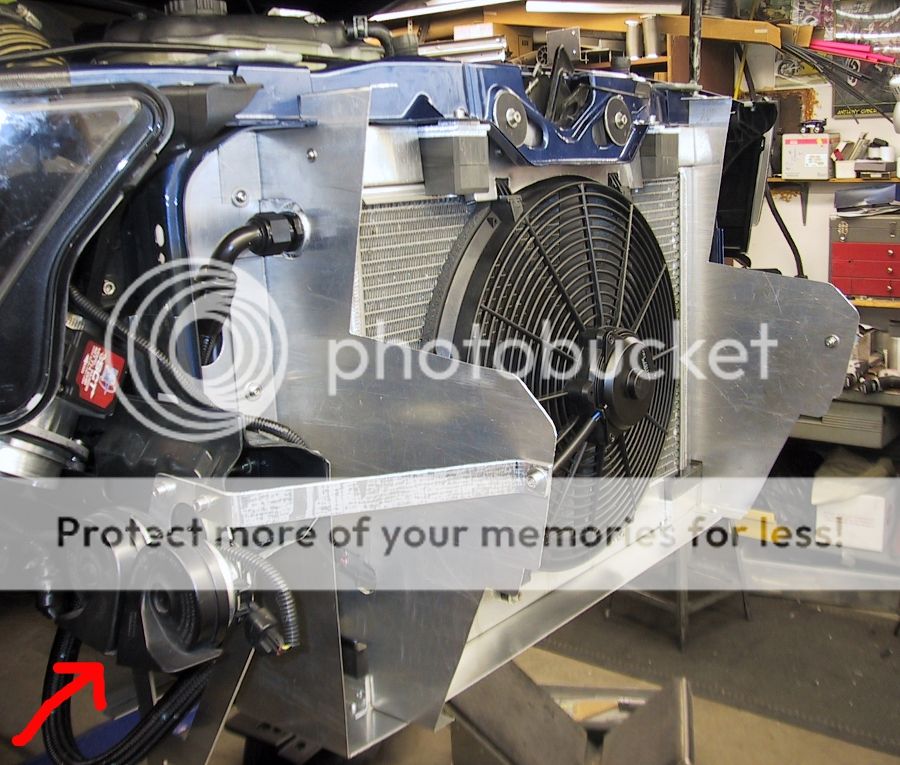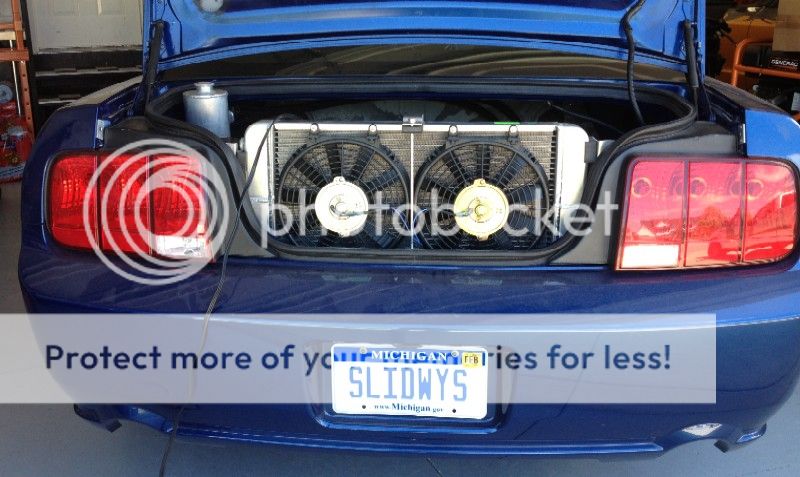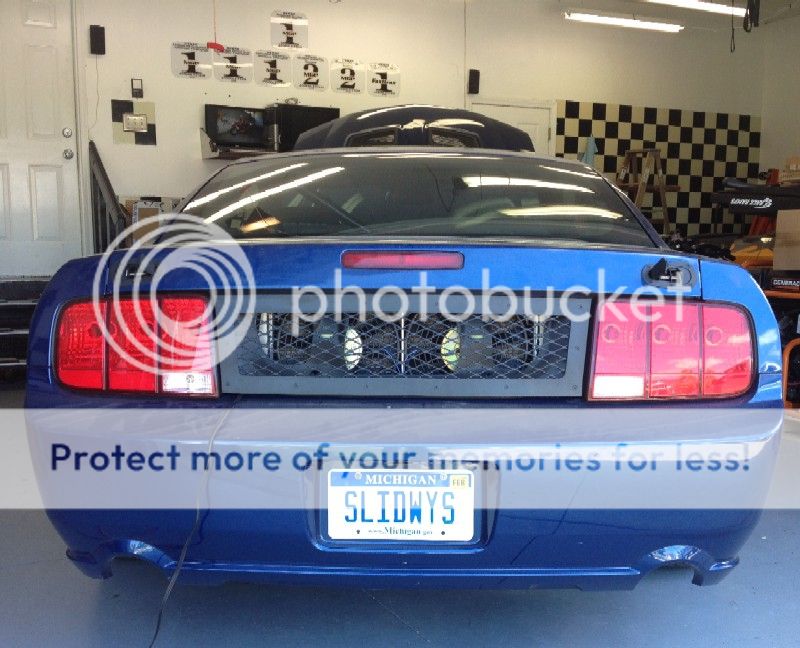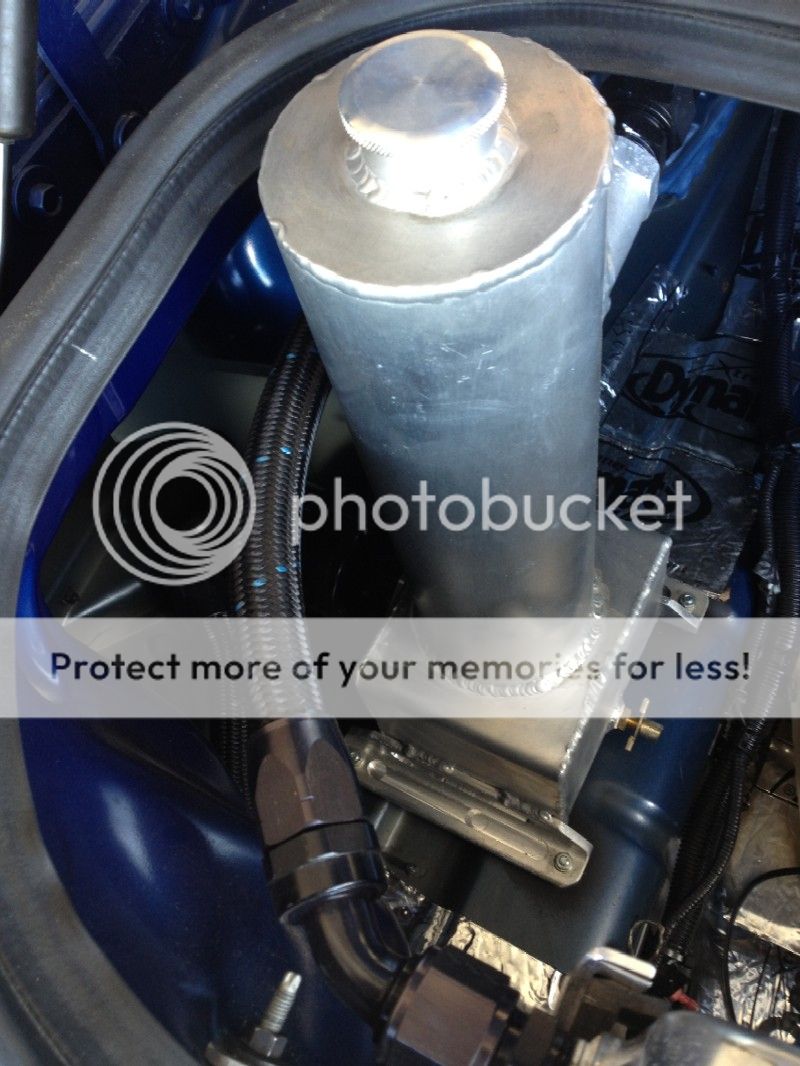Fullboogie
King of the Ski - OG Jr.
Ugh - that means battery relocation. By the way, I see you make reference to "we" and "at work". Who do you work for, if you don't mind me asking?
Ugh - that means battery relocation. By the way, I see you make reference to "we" and "at work". Who do you work for, if you don't mind me asking?
The other day I had IAT2's that were lower than my IAT1's sitting at a light. The IC system is doing its job and then some.
I experience this quite often as well, and my intercooler system doesn't work as well as yours. I'm always watching IAT1 (Ford calls it that too) as well, and would like to look at ways to improve it. At the drags I run my pump/fans in the staging lanes to cool the whole system down, so by the time I start my run, my IAT2's are near ambient. The problem I'm having is through the run, by 4th gear the system heats up so quick it starts pulling timing right at the end of the run. I am over spinning this Whipple so I'm sure it's putting out some heat. I'm just not sure if I need more volume, or more flow, or all of the above.
I experience this quite often as well, and my intercooler system doesn't work as well as yours. I'm always watching IAT1 (Ford calls it that too) as well, and would like to look at ways to improve it. At the drags I run my pump/fans in the staging lanes to cool the whole system down, so by the time I start my run, my IAT2's are near ambient. The problem I'm having is through the run, by 4th gear the system heats up so quick it starts pulling timing right at the end of the run. I am over spinning this Whipple so I'm sure it's putting out some heat. I'm just not sure if I need more volume, or more flow, or all of the above.






Can have a lot to do with your tune. I've noticed the spark vs. iat table is rather aggressive on the gt500.
I'm sure it is, but I'd rather address the heat than soften the tune. I'm already on the edge with this motor, so I'd rather pull a degree or two up top when IAT's get hot, than launch a rod out of the side. I'm sure you understand, lol.
I had already said I thought you could pump faster w a bigger HE. I wasn't trying an end around on ya lolYes, I see what you are getting at. If there is not enough HE in the system you will just be pumping hot/warm water faster. Which is of course not ideal, but I would still rather pump hot/warm water faster than slower.
For sure. Try to make the IC the biggest restriction. But aren't the HE cores more restrictive than IC. The IC tubes can get real bad expecially if the fins are stagger stacked.Even our big IC’s (2-3x the volume of the Saleen/GM IC’s) have more resrtiction than a -12 fitting/line. I’ve done the volume calculations with the Bell buys. The I.D. of the cores are quite a bit smaller and offer lot more restriction than you would think. As with most IC’s we run ours as a dual pass. One pass is 10x4.5x2.25 outside diameter, which seems pretty big. But the inside diameter and the fact that there are “fins” that run through the tubes which choke things down, reduces the flow dramaticaly. I don’t have my notes on this, we did these calcs over a year and a half ago. But one thing I will never forget is that the IC will not flow as much water as a -12 fitting/hose.
See I don't buy that either. Single pass might work better under perfect conditions, although idk how. Thing with the dual pass is you give the path some guidance. Otherwise path of least resistance applies and the whole core doesn't get used. We use baffles in vertical core IC's to make sure the flow path uses more core without the reatriction of a double pass.The Bell guys tell me that we would see a big performance increase if we ran the IC’s as single pass units (assuming you are feeding it enough water). A single pass is a packaging nightmare though and we would have to increase the HE inlet/outlet and all the hoses to at least 1” too. 1 1/4" being better. And that is not going to happen anytime soon if ever.
-16 minimum for everything here lolWe are running a true -12 everywhere. If I were starting from scratch (not going to happen) I would go -16 or -20. But that isn't going to happen.
It was w ice and 22psi. But the inlet rise would be the same either way, just different inlet temps.This is the “fuzzy math” part of the problem. How much water in the system? Are you using ice during those pulls? Then there is a HUGE-GANTIC difference between running on the dyno, running around on the street or running around the road course.
Most manufactures rate their system based on what they flow cfm wise. Paying no attention to real world applocation, or attention to the fact that cfm does not equal cooling capabilities.Getting a cooling system set up and able to handle “1000hp” in the dyno or run down the 1/4 is a COMPLETELY different than something that will handle 1000hp while driving around town or even worse yet hitting the road course. Our systems, especially mine will handle 1000hp on the dyno or the 1/4 with no problem. Mine would probably handle 2000+hp. But if you add heat soak (normal driving conditions) to that you are talking about completely different math. Kenne Bell’s “fuzzy math” is a perfect example of this. They say that their IC’s are good for 1400hp (no mention of pumps or HE’s though). Which I find to be helarious! I owned a KB rated at 1400hp. It was good for about 525-550 in the real world.
I know! Fuck heat exchangers. Don't run em, don't need em!! LOLAnd you guys are running turbo’s right? That is a HUGE advatage when talking about heat soak. A screw blower is making heat all the time, you guys are only making heat while under boost. Your systems have time to recover between “pulls”. A system working with a screw blower doesn’t get much recovery at all. Actually a screw blower will make more heat sitting there idling than crusing down the road. Roots improved blowers are better than screw blowers, but still don’t have the recovery time of a turbo.
Hood down down we would see 140 or so. But that is more the maf in an aluminum tube heat soaking the maf more than anything. It idle we don't produce heat, and IC is out front. Our inlets will go down once the air charge moves even without the pump on.That said turbo’s have their own heat soak issues. Do you do your dyno testing with the hood closed? There is a big difference in IAT’s with the hood open, especially when the air filter(s) are open to the engine compartment. With the hood open IAT1’s are nearly ambient. With the hood closed they can be 180deg+ real easy.
In an IC only system of course. It's the only reall restriction. But is the HE more restrictive than the IC? In our systems they would be more restrictive just for the fact we'd have to neck all the way down to -8 or -10 for the HE. Nobody makes them w -16 to -20 so I tell customer they are restrictive. Either way totally unneeded for us.I assure you, it is.
The 500 was probably done for packaging. We set up the flow path so incoming air charge sees the second pass of the water path first. As it pass thru that it sees the coldest last to finish the job. I'm converting the 500's to a single and doing the cooler like the coyote and double pass it. Be intersting to see but it will be a difference core design and compressor. But not apples to apples. But I'll shoot for the same boost, and will at least have a starting baselin to compare to.I can’t get a straight answer out of anyone if there is an advantage/disadvantage running it the two different ways. The DOB IC runs down one half (lets say the right half), turns around, and runs down the other half (lets say the left side). The GT500 IC runs down the top half, turns around, and then runs down the bottom half.
I think the GT500 is set up because of packaging. The Gt500 manifold is not very wide and there is not much room to get the water in/out running the fittings side by side either. They may have just done it that way because it was worked out the best.
I’m not saying the left/right routing is the most ideal. I really don’t know. But just about everyone sets them up like that. Which of course means absolutely nothing. I have seen lots of setups that were all identical, and wrong. Just because “everyone does it” doesn’t mean its right. As I mentioned above the best way to do it is to run the IC as a single pass, but no one does that because of packaging.
What pump and HE are you running?
What pulley combo? What RPM are you shifting at?
What CAI?
What TB?
Were about to de-rail the crap out of this thread!
So, for the last time: All of you "slow the coolant down" folks need to change your line of thinking.... Please!
Nick
Up untill a few days ago when I saw those Lingenfelter/Saleen tests I would have said the 20 and 55gpm Meizere pumps would always show gains. Now I’m having to calibrate that. Now I’m going to have to say on a low restriction system you will see gains, on a high restriction system you won’t.
You have a GT500 right? That is one of the lowest restriction systems there is. You will see gains with a Meziere pump.
But if someone asks me about a Saleen or an E-Force I’m going to have to give them a “it won’t hurt” answer.
And this whole thing has me thinking. Will the low restriction systems benefit from a higher pressure pump? Maybe not “high pressure”, just higher. I would like to test this, but it will take custom impellers.
Yup. I think that's what it is as well.I think more people just have the function of the intercooler and the heat exchanger confused.
I remember you guys. You referred to yourselves as glorified plumbersNow you can argue with me all you want, but I will ask you where you obtained your information. Me? I served in the Naval Nuclear Propulsion program. We tend to know a thing or two about pumps, fluid flow, and heat transfer.
So, for the last time: All of you "slow the coolant down" folks need to change your line of thinking.... Please!
Nick
For sure. Try to make the IC the biggest restriction. But aren't the HE cores more restrictive than IC. The IC tubes can get real bad expecially if the fins are stagger stacked.
Yep, and there is the rub. If it is hot designed/set up correctly you won’t be using the advantages that a single pass will give you. When I was considering going single pass I was going to feed it with two -12’s that split off of a -16 or -20 and do the same thing on the other end. Basically it would look just like our current IC but both of the fittings on the back would be feeds and there would be two more like it at the other end. And yeah, it still could possibly need some sort of flow deverter to fill the core evenly. Which wouldn’t be hard for us because we are making the tanks anyway. We could just incorporate the dirveter into the feed tank. It will probably never happen though.See I don't buy that either. Single pass might work better under perfect conditions, although idk how. Thing with the dual pass is you give the path some guidance. Otherwise path of least resistance applies and the whole core doesn't get used. We use baffles in vertical core IC's to make sure the flow path uses more core without the reatriction of a double pass.
If it is worth doing, it is worth over-doing.-16 minimum for everything here lol
 In retrospect I wish I had based the whole system on -16 lines. Too late now.
In retrospect I wish I had based the whole system on -16 lines. Too late now.Cheater!It was w ice and 22psi.

You lost me here. I think we are using different terminology for a few things. Can you elaborate? What is inlet rise?But the inlet rise would be the same either way, just different inlet temps.
But, but, Kenne Bell said so! LOL!Most manufactures rate their system based on what they flow cfm wise. Paying no attention to real world applocation, or attention to the fact that cfm does not equal cooling capabilities.
Yeah, we are definitly solving for two different problems (turbo vs. screw). And because I come from a road race background I don’t think I am trying to solve for exactly the same needs. For example, and ice cheat does me no good. It doesn’t even factor in to my “problem”. Now if I was setting up to run down the 1/4 there would be an ice chest involved for sure. I also solve for “street car” or “daily driver” too. Which is especially hard running a screw blower. Roots improved or TVS a little easier. The first thing I did when I got the car out this spring with the new blower/cooling system was go sit in traffic/run arrands in 90deg weather to see what it did. For a screw blown car that is a torture test! A tubo car would be dream!That is a problem for you guys though! Especially w space under an intake. I use the same IC as the stock GT500 core and make a ton more power than they can with lower inlets. But some 20% of core is blocked by the lower on top of the other hurdles. But for us we run an appropriate sized IC and that's about it. There's not mich to drag down the efficiency of the system as a whole.
Hood down down we would see 140 or so. But that is more the maf in an aluminum tube heat soaking the maf more than anything. It idle we don't produce heat, and IC is out front. Our inlets will go down once the air charge moves even without the pump on.
The 500 was probably done for packaging. We set up the flow path so incoming air charge sees the second pass of the water path first. As it pass thru that it sees the coldest last to finish the job. I'm converting the 500's to a single and doing the cooler like the coyote and double pass it. Be intersting to see but it will be a difference core design and compressor. But not apples to apples. But I'll shoot for the same boost, and will at least have a starting baselin to compare to.

If the cooling medium in an engine/intercooler is coolant, heat exchange will happen faster with faster flow. When air is the cooling medium used like a heat exchanger/radiator, you want the air to move faster, not the coolant. I didn't learn it in the nuke program and don't doubt your knowledge base, but I think you're applying it wrong. But if you don't think so, lay it on me homie.
Stock GT500 pump, Afco dual pass h/e with fans, 15% lower, 2.70" upper, 6500rpm, JLT 127mm carbon intake, and SCJ monoblade tbody.
300% more taint bad. Good voltage draw info too.Just fyi...
In this post I used an inline flow meter to measure coolant flow in an operational system with both the original Saleen pump and the Meziere 20 GPM pump
HOLY CRAP you are spinning the guts out of that sucker! I calculate you are spinning the blower to 19,572rpm. That is waaaaaaaay past its efficency range.
Dig these figures, I found them a few months ago in a test.
Compressing air, no matter how it is done creates heat. A 100% efficent compressor (no such thing) will get you about 9.5deg/psi. A roots improved blower in its efficency range will see about 13.25deg/psi. Screw blower in it’s efficency range about 11.5deg. Outside their efficency range it can be 15+deg/psi real easy.
What are you making? 18-19psi? Lets say you are getting 13deg/psi (which is probably a gift). That is 247deg. Then add your IAT1 temp…..90deg (another gift). That is 337deg blower discharge temps! It seems like fantasy that they can be cooled down to under 135deg (where timing is pulled). Let alone for a whole run.
When Ford started on the 2010 Cobra Jet (late 2008) they were vaporising the coolant while it was inside the IC. My tuner was the one tuning the test mules. When it started happening they didn’t know what was going on. Not untill they ran clear hose did they figure it out. They ran down the street to the marina and picked up some bilge pump to see if they could stop the vaporization. It did, but that was not the long term solutions. For took the test mules back to “headquarters” and went to town. The next time they showed up for testing they had a couple different pumps to test and a data aquasistion system with 70 channels to measure heat and pressure. They ended up going with the 55gpm Meziere.
I have also seen a friends 2.3L Whipple on a 3v spinning 18,000rpm vaporize the water in the IC too. He went to a 55gpm pump, no other changes (he already had the old big Afco on the car) and not only did it stop vaporizing the water, it kinda runs something near cool-ish.
Put a big pump on that bad boy.
Have you tried a slower pulley combo on the dyno? You are spinning that sucker so fast that you may be loosing everything you gain in parasitic loss and heat.
You may take a look at a bigger CAI too. I just put the JLT Super Big Air CAI on my car with the new/bigger blower and had it tuned. It’s the first time my tuner has used a CAI that big that wasn’t a custom jobbie on a race car. He thinks it’s the cats ass.
